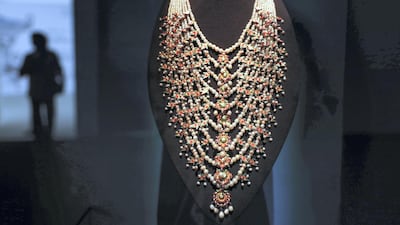Even in the darkness of the display cabinet at Louvre Abu Dhabi, it shines as an object of remarkable beauty and craftsmanship.
Some call it the Satlada – nine cascading strands of natural pearls adorned with plaques of white gems and blood-orange and green enamel.
More remarkable than the skill of those who made it about 140 years ago in India is the story of how it came to be in Abu Dhabi and put on display at the museum.
This is a necklace embedded in the story of the first days of the UAE.
It was owned by Sheikh Zayed, the Founding Father, and then by the queen of Arab song, Umm Kulthum or “Kawkab Al Sharq” (Star of the East), as she was popularly known.
The necklace was a gift from Sheikh Zayed to Umm Kulthum for performing in Abu Dhabi days before the Emirates united as one country on December 2, 1971, in celebrations that would also mark his fifth anniversary as Ruler of Abu Dhabi.
That Umm Kulthum would sing in Abu Dhabi was a sensation. She is arguably the greatest female voice the Arab world has ever produced. An imam’s daughter born in Egypt’s Nile Delta, such was her popularity and the power of her voice that it was said the streets of Cairo emptied of traffic when she sang live on radio.
Her performances were a tour de force. Accompanied by her orchestra, each song could last for up to an hour or longer, featuring improvisations and lengthy instrumental sections.
Fans included French leader Charles de Gaulle, who called her “The Lady”. Maria Callas, the opera singer, said she was the “Incomparable Voice”.
Even Bob Dylan was in awe, telling an interviewer in 1978: “She’s great. She really is. Really great.”
By the time of the first concert on November 29, 1971, poor health had forced Umm Kulthum to give up all other appearances for the year. But, as an admirer of Sheikh Zayed, she agreed to the invitation presented by a delegation from Abu Dhabi. She would be the biggest headline act to perform in Abu Dhabi, much bigger than Madonna or the Rolling Stones in more recent times.
The two concerts were announced in flowery style by Al Ittihad newspaper: “A grand artistic dream is materialising these days: the Lady of Arabic song will share in the festivities of accession day. The Star of the Orient will perform two evening concerts.”
But the interest in the concerts, along with the size of her orchestra, posed a particular problem for the city. There was nowhere large enough for the expected audience.
The solution was to build a concert hall under the supervision of Sheikh Faisal bin Sultan Al Qasimi, the chairman of the official celebrations.
In only two months, a 4,000-seat hall with brick walls, a sloping floor and steel roof went up near what is now Al Wadha Mall.
“We put on the final coat of paint the day before Umm Kulthum arrived,” Sheikh Faisal recalled in an interview in 2010. “We were exhausted.”
Umm Kulthum arrived at Al Bateen airport with her orchestra and an entourage that included family members.
Wearing her trademark scarf and sunglasses, she was greeted by the official welcoming party of Sheikh Zayed and President Sheikh Khalifa, who was Crown Prince of Abu Dhabi at the time. She was offered the use of a villa, but insisted on staying with her musicians at Al Ain Palace Hotel on the Corniche. Police controlled the crowds around the concert hall for the first performance, which began at 10.30pm on November 28 and was attended by Sheikh Zayed and other Al Nahyan family members, along with senior officials.
It is here that Sheikh Zayed is believed to have presented her with the necklace.
Afterwards, a radio interviewer in Cairo said Umm Kulthum told him “she had never had such a loyal audience as the one in the Emirates”.
Mohammed Al Qudsi, a TV journalist who was there, estimated the audience was double the hall’s official capacity. “It was an unforgettable night,” he said. “The atmosphere was amazing and happy, and the audience was completely mesmerised by her singing.”
A second concert followed on November 30 but Umm Kulthum was not quite ready to go home. As Sheikh Zayed journeyed to Dubai for the official ceremony of unification, she was a guest of Sheikh Khalifa to watch the flag of the UAE being raised for the first time over Al Manhal Palace. Umm Kulthum stopped performing in 1973. She died in February 1975. About four million people lined the streets of Cairo for her funeral.
She left behind a large collection of personal jewellery, but little was more precious than the necklace from Sheikh Zayed. In April 2008, it was put up for sale by her family at auction in Dubai.
The “imposing antique Indian natural pearl nine-row necklace”, certified by the Gem Testing Laboratory of Great Britain, was given an estimated price of between $80,000 (Dh293,840) and $120,000.
Two bidders ran up the price to $1.385 million. The identity of the buyer was never revealed, but he or she was reported to be from Abu Dhabi.
It would not be seen in public again for more than a decade, until the opening this October of the 10,000 Years of Luxury Exhibition at Louvre Abu Dhabi, where it is one of the highlights. According to the official description, the necklace is on loan from the Zayed National Museum, and will presumably form part of the permanent collection when it opens on Saadiyat Island.
Nearly half a century after it was presented by Sheikh Zayed, it will find a new home under the roof of the building that will carry his name.




